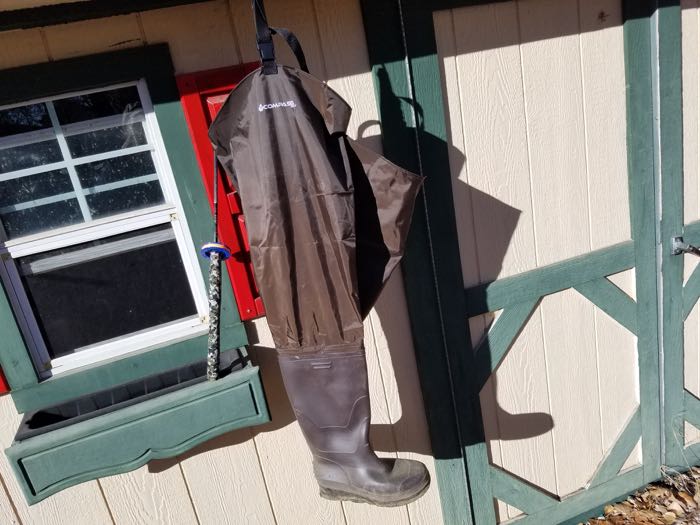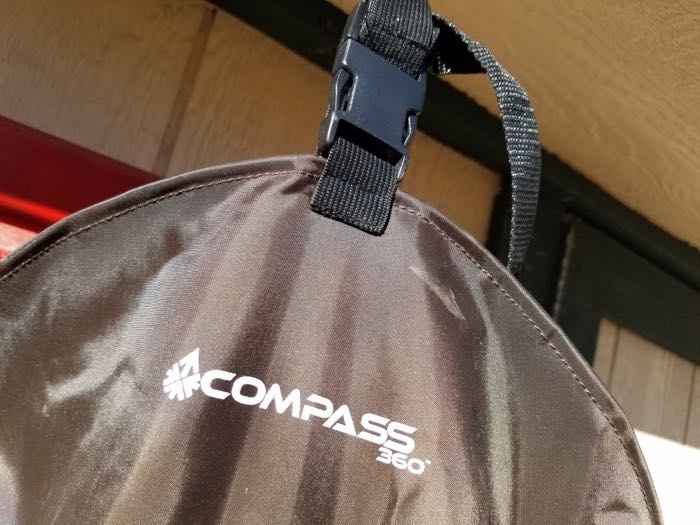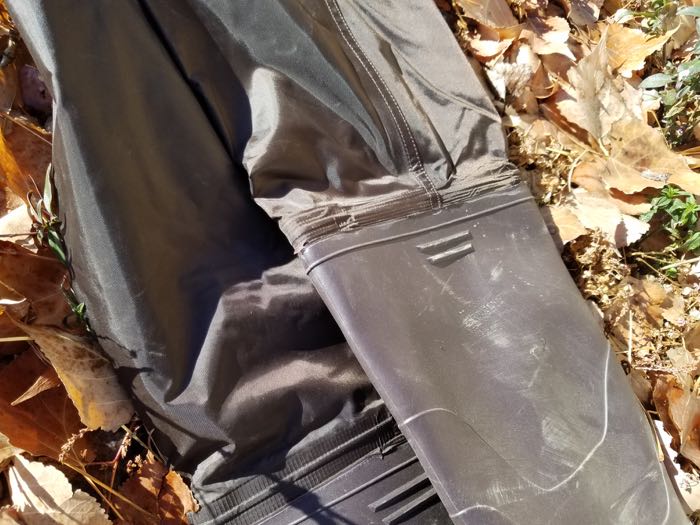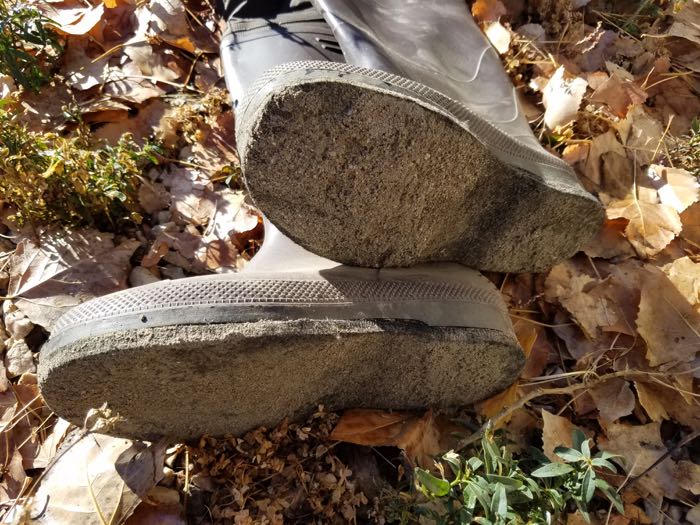
When you’ve been married to a sport for over 25 years, you develop a love/hate relationship with certain things. There are plenty of things I love about fly fishing, but there’s one thing I’ve always hated: waders. For the last few years, I’ve been using Orvis Silver Sonic breathable waders. Don’t get me wrong–they’re great. But they’re still waders. They still require that time-wasting, tortuous streamside ritual of awkwardly wiggling into them, then somehow managing to stuff your feet (which seemed normal-sized only a minute ago yet suddenly seem gargantuan) into (magically too small) wading boots, and lacing them up–all the while, trying to balance and not shred the neoprene stocking feet on the parking lot gravel.
It always felt like drudgery to me and I’ve often said that my favorite part of a day fishing was getting out of my waders.
Once on, they’re fine. They offer perfect waterproof protection up to my chest. The only problem was that I rarely wade deeper than my knees. Why was I torturing myself with chest waders that were a pain to get in and out of?
In the summer, I can wet wade. But in the fall and winter, I need waders. The water is just too cold. It took me long enough, but I finally decided to solve my dilemma with an old-school remedy: hip waders.
No matter how good they claim to be, I’ve always considered all waders to be disposable, so I didn’t want to spend a lot. After some research, I stumbled across the Compass 360 hip boots on Cabela’s for $39.99 + free shipping. I confess that I was a little skeptical and kind of felt like I was cheating on my tribe of high-end $300 waders, but I had also lost my devotion to them out of desperation. An affair seemed to be in order–no matter the disapproving looks of Orvis-clad fellow anglers on the stream.
After I got them, I was pleasantly surprised. Mostly by the fact that I could get in and out of them in 30 seconds. This was exactly what I was looking for!
And, the quality was better than I had expected for $40. While I haven’t had enough time to really put them through their paces, the materials seem good and the stitching is impeccable.

Even the welded seams on the boots look good.

They come with two sole options: felt or rubber treads. I opted for felt since that’s what I feel grips the best. And I don’t buy all that nonsense about felt transporting invasive species. That theory has long since been disproved whilst I was slipping and sliding around in Patagonia Rock Grips (which I like to call “Rock Slips”). I prefer felt over broken bones.

I’m not going to sugar coat it–the Compass 360 hip waders are your grandfather’s waders. They’re nylon and PVC and the boots don’t hug your feet the way a stocking-foot wader with laced wading boots would. They’re not comfortable on a long hike and they don’t provide any insulation. But I realized that most of the time, I don’t need that. I just need my feet to not get wet and skip the tailgate drama of chest waders.
These aren’t replacements for a serious pair of waders by any means. But they have their place. When I just need minimal wading protection on a non-technical creek, they’ll work just fine. But I’ve always got my fancy waders as a backup. It’s nice to have both. Case closed.








Jason,
Good explanation and insight into waders, thank you. You said, ” I don’t buy all that nonsense about felt transporting invasive species.” I live in upstate NY, Rochester, and I have heard the anti-felt argument often. What brought you to your conclusion?
Thanks,
Jim S.
No need to post- email would be fine
jason,i will check these out.a funny story about waders.about fifteen years ago i was out fishing the muskegon river for trout.my waders had a leak in them so i hung them up in my garage to drain and to dry out.i used to live just off a busy highway in paw paw michigan and some motorist called the local constabulary to report that i had a illegal deer hanging in my garage.so to make a long story short,the state police and the michigan dnr showed up to investigate the alleged deer story.in my garage they found my hanging waders.anyway they all laughed about the incident and i still fish with one of the guys that showed up to arrest me.but i am due for a new set of waders so i`m going to check out the ones you are talking about.
David, that’s probably one of the best stories I’ve heard.
If you don’t need chest waders for the water you’re fishing, I suppose there’s no real reason to use them. I can actually think of several rivers in my areas that hip waders would be more appropriate, certainly less of a hassle than chest waders.
Interesting choice. I never thought about using something else than chest wader but I get the point about how annoying it can be getting them on and off. It looks like they are definitely worth a try, especially for 40 bucks, if you know that you don’t need the features of decent chest waders plus wading boots. The reason I will probably stick to said combo is that I need the ankle and heel support to feel safe while wading through the river. If I wouldn’t fish on tricky grounds, like slippery, bigger stones I could probably go with those hip waders too.
One thing I find interesting is that you don’t buy the whole invasive species related to felt thing. Why is that? As far as I know the only reason that’s said is that felt tends to dry more slowly. As a result said invasive species survive longer- since they need moisture for that. In addition to that the surface of felt also makes it easier-for those species – to get stuck in there. Am I missing something?
Anyway, great read and nice to see that those hip waders aren’t “dead” yet, I feel like they have that special oldschool fly fishing flair!
Cheers
Sara
Hey Sara, thanks for your comment! To answer your question, the reason I don’t buy the whole thing about felt soles is that years ago, I was forwarded some studies that showed it was a myth. Intuitively, I had always thought that the blame on anglers was way out of proportion. Think about it–how many anglers would it take to cross-contaminate different waters carrying veligers better than birds, frogs, snakes, elk, deer, bears, moose, turtles, etc. Statistically, we’re in a very small minority if there is any transport whatsoever (and some studies say there isn’t at all). If you want to blame transport, blame wildlife. That’s my view. Freezing your felt soles isn’t going to prevent any significant transport when you only fish a couple of times a week while there are hundreds of other animals migrating between watersheds 24/7 while you eat, work, and sleep. So I guess my stand is based on a combination of some science and some logic. I don’t expect everyone to agree and it certainly wouldn’t hurt to be overly cautious–but in my opinion, it just isn’t necessary.
Thanks for your reply Jason!
Really interesting thought there and I agree on most of it. I think we are on the same page that the fly fisherman that only switches between his two local river doesn’t have to worry about this whole topic. Like you said, animals, especially, birds would spread invasive species the whole day, if it would work that way.
However, what I am still convinced about: Fly fishing is a sport known to bring people to places where they otherwise wouldn’t even think about going. This not only involves longer hikes but also drives and maybe even the occasional plane trip. To be honest I have no idea how long such species survive in felt, but they certainly do survive longer than on rubber. To get to the point, while an elk or a bird probably wouldn’t travel as much as you do on 6 hours car/plane trip. Let those species survive a few days in your boots and you might have something to worry about.
Anyway, that’s probably not something the average fisher has to care about, you are totally right with that.
Sara, I just sent you an email inviting you to have a convo offline about it. Hope to hear from you.
I wanted to chime in on the traction issue. I’ve used felt soles for decades and was convinced they offered the best traction, not anymore.
Aluminum bars are much better, no comparison in my opinion. My local river is in a granite watershed. The rocks are smooth with a layer of slime. Felt shoes slip on any other surface that isn’t mostly flat. The aluminum grips the rocks. It was actually a bit disconcerting initially. Instead of sliding my feet along the rocks I have to pick them up.
The bars on the boots are flat and a softer alloy. I had concerns about wearing them out quickly (they are replaceable) they showed wear after a few trips. That’s been over a year ago and they look pretty much the same. Probably don’t have to mention that they are much more secure out of the water than felt too.
As far a felt spreading disease yea maybe but if it gets banned then that’s that. Aluminum works, try it.